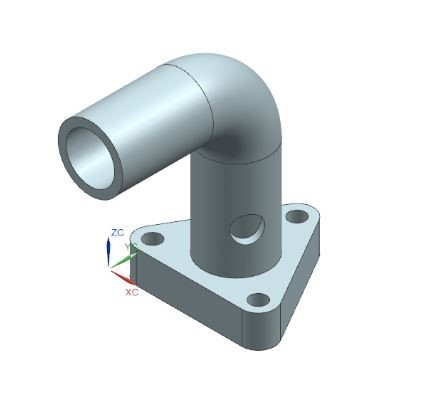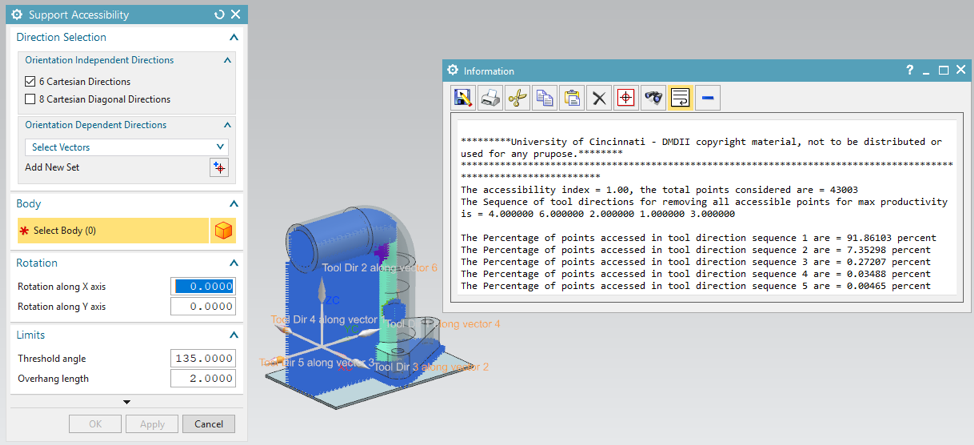Support Structures for Additive Manufacturing
Product: Siemens NX
Introduction

Figure 1: Sample part in Siemens NX on which analysis is conducted for the case study
Additive Manufacturing is slowly but steadily becoming the new industry standard for the manufacturing of various types of parts. Consumer products such as the Adidas sneakers to biomedical implants, precision electronics of nanoscale to large aircraft components (BAAM) are built using additive manufacturing. Apart from the select few who are actively involved in research and development of various AM processes, the core knowledge surrounding this process and its various characteristics are not commonly available for students. With Industry 4.0 and digital manufacturing gaining significant traction in today’s world, it is imperative for educational institutions to recognize the importance of incorporating AM in the course curriculum.
As a step forward, the University of Cincinnati has developed several additive manufacturing software modules within Siemens NX. Educating students about AM specific part design guidelines pertaining to support structures during the design phase of the part is the objective and motivation behind this effort. Before we dive into the details of the module, let us clear one simple concept – What is a support structure?
A support structure or more commonly supports are structures built along with the part to aid in the manufacturing of features that do not have any material underneath it. Such features can be called as overhang features which may fall down or collapse due to gravity in the absence of support structures during the build process. After the manufacture of the part, these support structures are removed from the actual part.
Now, the next question that may come up in the mind of a reader is why are they so important that we need to make software modules to analyze and build them? The answer to this question is three-fold. Ironically, support structures not only play an important role in the manufacturing of overhang features, they adversely affect the overall quality and surface finish of the end product. The process of removing the support structures causes poor surface finish of the part where the support structures come into contact with the part surface. The second reason is the requirement of material to build the support structures which then goes to waste when they are removed. Finally, additional post-processing efforts are required at the end of the build to remove the support structures using various machining processes or manual methods. Due to these reasons, the analysis and optimal placement of support structures during the design phase of the part is an important skill-set to possess for all manufacturing engineering students as well as industry personnel.
In this case study, the software modules created within Siemens NX to visualize, build, and analyze the removability of support structures are discussed with the help of part shown in Figure 1.
Support Visualization and Parameter Calculation Module
The objective of this software module is to provide the designer with quick feedback on the location of support structures along with numerical output on parameters such as support structure volume, support contact area, build height, and the area of the down-facing surfaces that do not require support structures. For fast processing and calculation of the said parameters, the support structures are represented by line curves. The outcome of this module is the ability to expedite the downstream optimization processes which involve design updates and rotation of the part in different orientations to check the optimal build setup. Figure 2 shows the output of the support visualization tool.

Figure 2: GUI and Output Window of the Support Visualization Tool in Siemens NX
Support Structure Generation Module
As mentioned earlier, support structures are required to build overhanging features in the part model. In this software module, as shown in figure 3, support structures are created as CAD objects which are integrated with the part model to form one single part file. This part file can be converted to the STL file format which then gets transformed into CLI/SLI files that are readable by an AM machine. The main outcome of this module is the multiple options provided to the designer to create different support structure types such as solid, hollow, surface, and supports with honeycomb cross-sections. This module also gives the designer the ability to make different types of support structures within the same part based on the load requirement of the actual part. Due to the creation of actual CAD bodies for each support column, this module takes more time than the support structure visualization tool.

Figure 3: GUI and Output Window of the Support Generation Tool in Siemens NX
Accessibility and Setup Analysis Module
Support structures need to be removed from the actual part after the build. Depending on the type of AM process, support structures are removed using an EDM tool or manually. In this process of removal of support structures, the most important concern is time. To reduce the overall time taken to build a finished part, it is important to reduce the number of machining tool setups required to remove all the support structures. This module is aimed at providing the designer an ability to foresee the down-stream post-processing efforts. An optimized tooling setup sequence is provided to remove maximum possible support structures based on the orientation of build. Figure 4 shows the output of the accessibility and setup analysis for the same orientation used to create support structures in the design example used for the first two modules.

Figure 4: GUI and Output Window of the Accessibility and Setup Analysis Tool in Siemens NX
The software modules created within Siemens NX serves a key tool to educate students and industry personnel about support structures required for Additive Manufacturing.
The collaboration of the University of Cincinnati with Siemens PLM Software has facilitated the development of these software modules. It is our hope that these tools will serve as a key element in educating undergraduate students to achieve the necessary skill-set to ace in this ever-developing Additive Manufacturing environment.